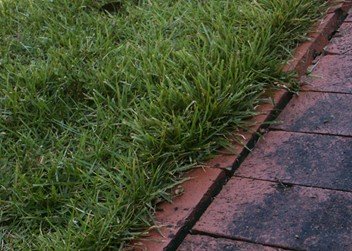Planting and Growing
Warm Season Grass
Warm Season Grass is a term given to various grass species that thrive best in summer temperatures between 80 and 95 degrees. Their primary range of adaptation is in the southern and western regions of the country and also the area known as the transition zone. Click on the link to see a map of turfgrass adaptation zones.
(For a detailed description of warm season grasses and how to care for them, see the bottom of this page.)
The environmental conditions in which they can thrive are quite broad. Some grass types grow best in hot, drier climates while other types grow best in tropical regions.
Seed or Sod
Some types can be planted by seed. Others can only be planted by plugs, squares or sod. Zoysia seed, for example, is very expensive, as of this writing about $50.00 a lb. and can take over a year to germinate. Common bermudagrass seed is relatively inexpensive, but more expensive than most cool season grass seed. There is no St. Augustine seed. It must be planted by vegetative methods only.
In the U.S. most grasses are restricted to the southern half of the country, but some varieties of zoysiagrass and buffalograss can handle cold weather as for north as Canada.
Popular Warm Season Grass Types
Some of the most popular grass types are
- bermuda grass
- zoysia grass
- St. Augustine grass
- bahia grass
- centipede grass
- carpet grass
- buffalo grass
Kikuyu grass is another grass grown along the California coastal regions and can be extremely aggressive. It can cover fences, shrubs and bushes and even smother other grass types. It can produce unsightly seedheads one day after mowing and, once established, is difficult to control.
The reason these grasses are able to thrive in hot climates is due to its genetic structure. It takes more energy to actively grow in hot weather, so these grasses are more efficient at carbohydrate production. They also produce deeper roots than their cool season counterparts. The deeper roots help the grass remain green during long periods of drought. See the Photosynthesis page for a better understanding on how grasses grow. It will change the way you think about your lawn.
Most hot weather grasses are known for their ability to spread by the production of rhizomes and stolons. Rhizomes are stems that grow horizontally just below the soil surface while stolons are horizontal stems that grow on top of the soil. These stems sprout new plants along its length. Stems from common bermudagrass can grow to be several feet long. See the Plant Structure page for detailed information about rhizomes and stolons.
The links below provide complete details on the various warm seasn grasses including Pros and Cons, Care and Maintenance, and disease and insects, plus much more.
Common and Improved Varieties of Bermudagrass
Bermudagrass is the most popular warm season grass in America. Read about the pros and cons of planting this grass, along with all you need to know to take care of your lawn.
Zoysia Grass
Zoysia grass was imported from the Orient and has become one of the leading warm season grasses in the U.S. Click here to learn about this beautiful grass and tips on how to care for it.
St Augustine Grass
St Augustine grass is a favorite hot weather grass adapted to the coastal and southern regions of the U.S. from Florida to central Texas. Click here for information on growth habits, maintenance and lawn care tips.
Buffalo Grass
Buffalo Grass, native to the U.S. Western Plains, once fed millions of American bison (buffalo) has now become a beautiful lawn and sports grass. Click here for buffalo grass facts, care and maintenance tips, adaptation range, popular varieties, and much more.
Centipede Grass - The Lazy Man's Turfgrass
Centipede grass is a low maintenance, low fertility and slow growing turf grass that is adapted to the southern coastal regions of the U.S. Click here for detailed information on how to plant and care for this grass.
Overseeding Lawns - Detailed Tips and Techniques
Complete instructions and techniques for overseeding lawns. Bermudagrass is the most frequently overseeded warm season grass. Find out how to do this as well along with the types of seed you can use.
Lawn Winterization Tips and Techniques
Fall winterization is the most important time for fertilizing cool season grasses. Warm season grasses do not receive the same treatment. Find everything you need to know to winterize both cool and warm season grasses.
Plant Growth Regulators
Plant Growth Regulators are just beginning to be discovered by homeowners. They are fantastic products with dozens of uses for everything from slowing grass growth to eliminating unwanted tree fruit. Click here to discover what you have been missing.
Warm Season Grass to Lawn Care Academy Home




